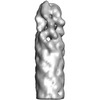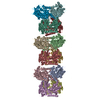[English] 日本語
 Yorodumi
Yorodumi- EMDB-2805: Refined negative stain electron microscopy reconstruction of the ... -
+ Open data
Open data
- Basic information
Basic information
| Entry | Database: EMDB / ID: EMD-2805 | |||||||||
|---|---|---|---|---|---|---|---|---|---|---|
| Title | Refined negative stain electron microscopy reconstruction of the tip complex from the type III secretion system of Shigella flexneri with MxiH mutation Q51A | |||||||||
 Map data Map data | Reconstruction of the tip complex and needle from the type III secretion system of Shigella flexneri with MxiH mutation Q51A and using groups of individual images | |||||||||
 Sample Sample |
| |||||||||
 Keywords Keywords | Tip complex / Type III secretion system / Shigella flexneri / Refined Q51A | |||||||||
| Biological species |  Shigella flexneri (bacteria) Shigella flexneri (bacteria) | |||||||||
| Method | single particle reconstruction / negative staining / Resolution: 19.0 Å | |||||||||
 Authors Authors | Cheung M / Shen D / Makino F / Kato T / Roehrich D / Martinez-Argudo I / Walker ML / Murillo I / Liu X / Pain M ...Cheung M / Shen D / Makino F / Kato T / Roehrich D / Martinez-Argudo I / Walker ML / Murillo I / Liu X / Pain M / Brown J / Frazer G / Mantell J / Mina P / Todd T / Sessions RB / Namba K / Blocker AJ | |||||||||
 Citation Citation | Journal: Proc Natl Acad Sci U S A / Year: 2008 Title: What's the point of the type III secretion system needle? Authors: Ariel J Blocker / Janet E Deane / Andreas K J Veenendaal / Pietro Roversi / Julie L Hodgkinson / Steven Johnson / Susan M Lea /  Abstract: Recent work by several groups has significantly expanded our knowledge of the structure, regulation of assembly, and function of components of the extracellular portion of the type III secretion ...Recent work by several groups has significantly expanded our knowledge of the structure, regulation of assembly, and function of components of the extracellular portion of the type III secretion system (T3SS) of Gram-negative bacteria. This perspective presents a structure-informed analysis of functional data and discusses three nonmutually exclusive models of how a key aspect of T3SS biology, the sensing of host cells, may be performed. | |||||||||
| History |
|
- Structure visualization
Structure visualization
| Movie |
 Movie viewer Movie viewer |
|---|---|
| Structure viewer | EM map:  SurfView SurfView Molmil Molmil Jmol/JSmol Jmol/JSmol |
| Supplemental images |
- Downloads & links
Downloads & links
-EMDB archive
| Map data |  emd_2805.map.gz emd_2805.map.gz | 19.7 MB |  EMDB map data format EMDB map data format | |
|---|---|---|---|---|
| Header (meta data) |  emd-2805-v30.xml emd-2805-v30.xml emd-2805.xml emd-2805.xml | 16.3 KB 16.3 KB | Display Display |  EMDB header EMDB header |
| Images |  EMD-2805.png EMD-2805.png | 48.3 KB | ||
| Archive directory |  http://ftp.pdbj.org/pub/emdb/structures/EMD-2805 http://ftp.pdbj.org/pub/emdb/structures/EMD-2805 ftp://ftp.pdbj.org/pub/emdb/structures/EMD-2805 ftp://ftp.pdbj.org/pub/emdb/structures/EMD-2805 | HTTPS FTP |
-Validation report
| Summary document |  emd_2805_validation.pdf.gz emd_2805_validation.pdf.gz | 216.3 KB | Display |  EMDB validaton report EMDB validaton report |
|---|---|---|---|---|
| Full document |  emd_2805_full_validation.pdf.gz emd_2805_full_validation.pdf.gz | 215.4 KB | Display | |
| Data in XML |  emd_2805_validation.xml.gz emd_2805_validation.xml.gz | 6 KB | Display | |
| Arichive directory |  https://ftp.pdbj.org/pub/emdb/validation_reports/EMD-2805 https://ftp.pdbj.org/pub/emdb/validation_reports/EMD-2805 ftp://ftp.pdbj.org/pub/emdb/validation_reports/EMD-2805 ftp://ftp.pdbj.org/pub/emdb/validation_reports/EMD-2805 | HTTPS FTP |
-Related structure data
| Related structure data |  2801C  2802C  2803C  2804C  2806C  4d3eC C: citing same article ( |
|---|---|
| Similar structure data |
- Links
Links
| EMDB pages |  EMDB (EBI/PDBe) / EMDB (EBI/PDBe) /  EMDataResource EMDataResource |
|---|
- Map
Map
| File |  Download / File: emd_2805.map.gz / Format: CCP4 / Size: 29.8 MB / Type: IMAGE STORED AS FLOATING POINT NUMBER (4 BYTES) Download / File: emd_2805.map.gz / Format: CCP4 / Size: 29.8 MB / Type: IMAGE STORED AS FLOATING POINT NUMBER (4 BYTES) | ||||||||||||||||||||||||||||||||||||||||||||||||||||||||||||||||||||
|---|---|---|---|---|---|---|---|---|---|---|---|---|---|---|---|---|---|---|---|---|---|---|---|---|---|---|---|---|---|---|---|---|---|---|---|---|---|---|---|---|---|---|---|---|---|---|---|---|---|---|---|---|---|---|---|---|---|---|---|---|---|---|---|---|---|---|---|---|---|
| Annotation | Reconstruction of the tip complex and needle from the type III secretion system of Shigella flexneri with MxiH mutation Q51A and using groups of individual images | ||||||||||||||||||||||||||||||||||||||||||||||||||||||||||||||||||||
| Projections & slices | Image control
Images are generated by Spider. | ||||||||||||||||||||||||||||||||||||||||||||||||||||||||||||||||||||
| Voxel size | X=Y=Z: 2.12 Å | ||||||||||||||||||||||||||||||||||||||||||||||||||||||||||||||||||||
| Density |
| ||||||||||||||||||||||||||||||||||||||||||||||||||||||||||||||||||||
| Symmetry | Space group: 1 | ||||||||||||||||||||||||||||||||||||||||||||||||||||||||||||||||||||
| Details | EMDB XML:
CCP4 map header:
| ||||||||||||||||||||||||||||||||||||||||||||||||||||||||||||||||||||
-Supplemental data
- Sample components
Sample components
-Entire : Conformation of the tip complex from the type III secretion syste...
| Entire | Name: Conformation of the tip complex from the type III secretion system of Shigella flexneri bound to the needle with MxiH mutation Q51A |
|---|---|
| Components |
|
-Supramolecule #1000: Conformation of the tip complex from the type III secretion syste...
| Supramolecule | Name: Conformation of the tip complex from the type III secretion system of Shigella flexneri bound to the needle with MxiH mutation Q51A type: sample / ID: 1000 Details: Tip complexes were analysed from purified needle complexes and therefore when still bound to the needle tip Oligomeric state: Five subunits of the tip complex bound to fifty subunits of the needle Number unique components: 2 |
|---|---|
| Molecular weight | Theoretical: 680 KDa |
-Supramolecule #1: Tip complex and needle
| Supramolecule | Name: Tip complex and needle / type: organelle_or_cellular_component / ID: 1 / Number of copies: 1 / Oligomeric state: Heteropentameric / Recombinant expression: Yes |
|---|---|
| Ref GO | 0: GO:0030257 |
| Ref INTERPRO | 0: IPR006135 |
| Source (natural) | Organism:  Shigella flexneri (bacteria) / Strain: serotype 5a / Organelle: Type III secretion system Shigella flexneri (bacteria) / Strain: serotype 5a / Organelle: Type III secretion systemLocation in cell: Extracellular component of membrane embedded complex |
| Molecular weight | Theoretical: 210 KDa |
| Recombinant expression | Organism:  Shigella flexneri (bacteria) / Recombinant strain: M90T derivative / Recombinant plasmid: pACT3, pBAD Shigella flexneri (bacteria) / Recombinant strain: M90T derivative / Recombinant plasmid: pACT3, pBAD |
-Supramolecule #2: Tip complex and needle
| Supramolecule | Name: Tip complex and needle / type: organelle_or_cellular_component / ID: 2 / Number of copies: 1 / Recombinant expression: Yes |
|---|---|
| Ref GO | 0: GO:0030257 |
| Ref INTERPRO | 0: IPR006135 |
| Source (natural) | Organism:  Shigella flexneri (bacteria) / Strain: serotype 5a / Organelle: Type III secretion system Shigella flexneri (bacteria) / Strain: serotype 5a / Organelle: Type III secretion systemLocation in cell: Extracellular component of membrane embedded complex |
| Molecular weight | Theoretical: 470 KDa |
| Recombinant expression | Organism:  Shigella flexneri (bacteria) / Recombinant strain: M90T derivative / Recombinant plasmid: pACT3, pBAD Shigella flexneri (bacteria) / Recombinant strain: M90T derivative / Recombinant plasmid: pACT3, pBAD |
-Experimental details
-Structure determination
| Method | negative staining |
|---|---|
 Processing Processing | single particle reconstruction |
| Aggregation state | particle |
- Sample preparation
Sample preparation
| Concentration | 0.1 mg/mL |
|---|---|
| Buffer | pH: 8 Details: 0.1% (w/v) DDM, 150 mM NaCl, 25 mM Tris pH 8, 5 mM EDTA |
| Staining | Type: NEGATIVE Details: Carbon coating mica sheets were submerged in a drop of 0.01% (w/v) DDM until the carbon sheet partially detached from the mica. The mica was then submerged in the sample for 5 s, then ...Details: Carbon coating mica sheets were submerged in a drop of 0.01% (w/v) DDM until the carbon sheet partially detached from the mica. The mica was then submerged in the sample for 5 s, then submerged in a drop of water for 5 s. The mica was then placed onto the surface of a drop of 1% uranyl acetate and allowed to sink, causing the carbon to float on the surface of the drop. After 10 s, the carbon sheet was adsorbed onto a grid. |
| Grid | Details: 300 mesh copper grid with a thin carbon film to which the specimen was adsorbed to |
| Vitrification | Cryogen name: NONE / Instrument: OTHER |
- Electron microscopy
Electron microscopy
| Microscope | FEI TECNAI 20 |
|---|---|
| Alignment procedure | Legacy - Astigmatism: Thon rings visualised at 50-100,000 times magnification using the fast FT and corrected accordingly Legacy - Electron beam tilt params: 0 |
| Date | Aug 31, 2011 |
| Image recording | Category: CCD / Film or detector model: FEI EAGLE (4k x 4k) / Digitization - Sampling interval: 15 µm / Number real images: 250 / Average electron dose: 9 e/Å2 / Camera length: 460 / Od range: 3.56 / Bits/pixel: 16 |
| Electron beam | Acceleration voltage: 200 kV / Electron source: LAB6 |
| Electron optics | Calibrated magnification: 70754 / Illumination mode: FLOOD BEAM / Imaging mode: BRIGHT FIELD / Cs: 2 mm / Nominal defocus max: 1.4 µm / Nominal defocus min: 1.4 µm / Nominal magnification: 50000 |
| Sample stage | Specimen holder: FEI single tilt holder / Specimen holder model: SIDE ENTRY, EUCENTRIC |
- Image processing
Image processing
| Details | Particles were selected using helix boxer from EMAN2. After alignment, Euler angles were determined by projection matching with projections of a map Q51A. The reconstruction was iterated and helical pattern searching and imposition was applied to each new reference generated after each iteration. |
|---|---|
| CTF correction | Details: First zero set to 18 angstrom, no CTF correction not required |
| Final reconstruction | Applied symmetry - Point group: C1 (asymmetric) / Algorithm: OTHER / Resolution.type: BY AUTHOR / Resolution: 19.0 Å / Resolution method: OTHER Software - Name: EMAN2, SPIDER, bespoke-2D-alignment, bespoke-X-and-Y-shifting Number images used: 2545 |
| Final angle assignment | Details: SPIDER: theta 4 degrees |
 Movie
Movie Controller
Controller


 UCSF Chimera
UCSF Chimera








 Z (Sec.)
Z (Sec.) Y (Row.)
Y (Row.) X (Col.)
X (Col.)





















